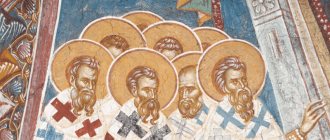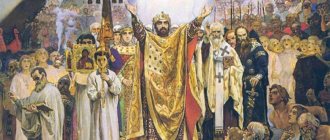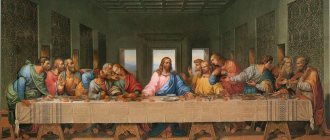Arianism is one of the most ancient Christian heresies. Its representatives declared the creatureliness of Jesus Christ, and that is why this teaching was rejected by the Christian Church.
The fight against Arianism played a decisive role in the formation of the orthodox doctrine of the Trinity, which put forward the dogma of the fullness of divinity in Christ as the Son of God. Thus, while fighting this heretical teaching, Christians developed a canonical understanding of the fullness of divinity in Christ as God and the Son of God.
What is heresy
Heresy is a deliberate distortion of the teachings of any religion. This could be either a retreat in the understanding of certain theological dogmas or the creation of separate religious schools or sects.
During the formation of Christianity, various heretical teachings posed a serious threat to the church. The basic tenets of the religion had not yet been streamlined and clearly formulated, which gave rise to many interpretations that often contradicted the very essence of the Christian faith.
Most of the heresiarchs of the Middle Ages were sincere believers, well-educated and famous preachers. They were popular and had a certain influence on people.
Heresy in the service of politicians
But the Christian martyrs who suffered during the time of Emperor Zeno the Isaurian in the Kingdom of the Vandals, which they created in the conquered lands of North Africa - in the territory of modern Tunisia, Northern Algeria, the northwestern part of Libya and the islands of Corsica and Sardinia - became victims not so much of a religious as a political crisis.
|
Prerequisites for the emergence of Arianism
During the first centuries of Christianity, its followers were subjected to severe persecution throughout the world. Only in 313, the emperors Constantine and Licinius issued the Edict of Milan, according to which all faiths on the territory of Rome were recognized as equal.
By the time Arianism appeared, the persecution of believers had ceased and the Christian church had taken a dominant position in the Roman Empire. Her influence on social and political life spread very quickly. Thus, discord within the church affected the life of the entire imperial structure.
Heresies and schisms were common at that time. They were not always based on ideological theological differences. Often disagreements arose from a clash of various economic, political, and ethnic interests. Some social groups tried to use religion to fight for their own rights.
In addition, many well-educated, thoughtful people came to the church. They began to raise issues that had not previously been considered significant. For example, different understandings of the doctrine of the Holy Trinity became the impetus for the emergence of Arianism.
Arian Creed
Describing his doctrine, the creator of Arianism indicates in a letter to Eusebius of Nicodemus that the Son cannot be either the Unbegotten (that is, God) or a part of him, since he was created by him before the creation of times and ages. Thus, Arius claims, Christ is not God, since he did not exist before him, but was born or created by him later.
Arian Baptistery in Ravenna. Italy: The mosaic shows that the human nature of Christ is emphasized
According to the testimony of the church historian Socrates Scholasticus, Arius began to assert the subsistence of God the Father and God the Son in the wake of his dispute with Bishop Alexander. The latter said that “The Holy Trinity is a unit in the Trinity.” He also says that the presbyter considered this statement an attempt by Alexander to disseminate the monarchist doctrine of the Trinity, which was developed by Savelius of Libya. According to him, it is understood as successive modes of a single god.
The essence of Arianism
So what is this heresy that has shaken up the entire Christian world? In short, Arianism is the doctrine according to which Jesus Christ is the creation of God the Father, therefore, is not consubstantial (that is, equal) to him, but stands lower. Thus, God the Son does not possess the fullness of divinity, but becomes only one of the instruments of a higher power.
Later, Arius somewhat softened his position, calling the Son the most perfect creation of the Father, not like the others. But the essence still remains the same.
The Arian heresy contradicts the modern understanding of the dogma of the Holy Trinity, which asserts that all divine hypostases, Father, Son and Holy Spirit, are consubstantial, without beginning and equal.
But the early Christian church did not yet have clearly formulated dogmas. There was no single creed yet. Theologians each used their own terminology and were calm about debates and discrepancies. Only with the coming to power of Constantine the Great did the Roman Empire demand that the church accept a single teaching with precise formulations.
General church history of Arianism: from the birth of Arius to his loss in the election of archbishop
The general church history of Arianism testifies that Arius was a Berber. He was born in 256 in Libya and did not come from a noble family. The most famous anti-Christian doctrine, Arianism, received its name from him. As a child, he was raised by Lucian of Antioch.
Arius, 1493, the inscription on the image indicates his classification as a heresiarch, that is, the creators of heresies
Upon his arrival around 311, he arrived in Alexandria, where he was ordained deacon by Archbishop Peter of Alexandria. Somewhat later, the archbishop noticed the newly minted deacon’s commitment to such heresy as Melitianism and excommunicated him from the church.
However, the excommunication did not last long, since Archbishop Peter soon suffered martyrdom during the period of renewed persecution of Christians. Archbishop Achilles ordained the repentant Arius as a presbyter of the Alexandrian Church.
After the death of Achilles, the presbyter applied for his place, but lost in the elections.
Later, his followers cited this fact as an example of his nobility, since they claimed that he refused the votes cast in his favor in favor of his opponent. Orthodox historians, with whom the Arians did not agree, point to the loss in the elections.
Priest Arius
Arius, after whom the doctrine is named, was a prominent preacher and thinker of the 4th century. He served as an elder of the Bakkal Church in the city of Alexandria. Arius was a talented and charismatic person, a favorite of the people. The Alexandrian bishop Achilles, before his death, named him as one of his successors.
But his rival Alexander won the struggle for the episcopal throne. He was an ardent opponent of the Arian heresy and began full-scale persecution of the presbyter and his followers. Arius was excommunicated from the church, defrocked and fled to Nicomedia. The local bishop Eusebius warmly stood up for him. It was in the east that the teachings of Arius were received especially favorably and gained many supporters.
When Emperor Constantine ascended the throne after defeating Licinius in 324, he came face to face with the heated ecclesiastical disputes. His idea was to make Christianity the state religion of the Roman Empire. Therefore, he actively intervened in the discussion and sent his envoys to Arius and Alexander demanding reconciliation.
But the political and religious views of these people were too different to easily forget their differences. And in 325, the first Ecumenical Council in church history was convened in Nicaea.
“Brother will betray brother to death”
When Emperor Zeno in 480–481 demanded that the Vandal king Huneric fill the vacant episcopal positions in Carthage, he responded by demanding equal rights for the Arian Church in Constantinople and other eastern provinces. And if Byzantium did not agree to these conditions, Huneric threatened to deport all the Orthodox bishops of the Vandal kingdom “to the Moors.”
Relations between the Vandals and Byzantium worsened, and severe persecution of Orthodox Christians began in North Africa. The edict promulgated by Huneric demanded that all Christians convert to Arianism no later than June 1, 482. Those who did not obey were burned at the stake or otherwise executed. The Byzantine historian Procopius of Caesarea and Saint Isidore of Seville call Huneric the most cruel and unjust persecutor of Christians in Africa.
|
What are church councils
The tradition of church councils began in the year 50, when the apostles, according to the book of Acts, gathered together in Jerusalem on the day of Pentecost. Since then, church hierarchs have met to resolve serious problems affecting the entire church.
But until now these meetings were limited only to local bishops. No one before Constantine could have imagined a discussion of questions of doctrine at the level of the entire Roman Empire. The new emperor was going to strengthen his power with the help of Christianity, and he needed scale.
The Russian word “universal” is a translation of the Greek “inhabited earth.” For the Greco-Roman Empire, this meant that the decisions of the councils were made throughout the entire territory known to them. Today these decrees are considered significant for the entire Christian church. The Orthodox world recognizes the decisions of seven councils, the Catholic world recognizes many more.
Council of Nicaea
The first Ecumenical Council took place in Nicaea in 325. This city was located next to the eastern imperial residence of Nicomedia, which made it possible for Constantine to personally attend the debates. In addition, Nicaea was the fiefdom of the Western church, where Arius had few supporters.
The emperor considered the party of the Bishop of Alexandria stronger and more suitable to lead the dominant church, so he took his side in the dispute. The authority of Rome and Alexander significantly influenced the decision.
The council lasted about three months, and as a result, the Nicene Creed was adopted, based on the Caesarea baptismal symbol with some additions. This document affirmed the understanding of the Son of God as uncreated and consubstantial with the Father. The Arian heresy was condemned and its supporters sent into exile.
Arianism after the Council of Nicaea
Almost immediately after the completion of the Ecumenical Council, it became clear that not all bishops support the new Creed. It was very different from the traditions that had developed in the eastern dioceses. The teachings of Arius were seen as more logical and intelligible, so many advocated the adoption of compromise formulations.
Another stumbling block was the word “consubstantial.” It is never used in the texts of Holy Scripture. Moreover, it was associated with the modalist heresy, condemned at the Council of Antioch back in 268.
Emperor Constantine himself, seeing that the schism of the church only intensified after the expulsion of the Arians, spoke out in favor of softening the wording of the Creed. He returns the expelled bishops and sends the Nicene supporters into exile. It is known that at the end of his life he even received baptism from one of the most devoted Arian priests, Eusebius of Nicomedia.
The emperor's sons supported various Christian movements. Therefore, Niceneism flourished in the west, and the Arian heresy, but in a more moderate version, flourished in the east. Her followers called themselves Omiy. Even Arius himself was pardoned and was already preparing for the return of his priesthood, but he suddenly died.
In essence, Arianism was the dominant trend until the convening of the Ecumenical Council in Constantinople. This was also facilitated by the fact that mainly representatives of the Eastern Church were sent as missionaries to the barbarian tribes in Europe. Many of the Visigoths, Vandals, Rugians, Lombards and Burgundians converted to Arianism.
Second Ecumenical Council
Emperor Theodosius, who succeeded Julian the Apostate on the throne, issued a decree according to which all who refused to accept the Nicene symbol were declared heretics. To finalize the unified teaching of the church, the Second Ecumenical Council was convened in May 381 in Constantinople.
By this time, the position of the followers of Arius had already weakened significantly even in the east. The pressure from the emperor and the Niceans was too strong, so the moderate Omiyas either moved into the fold of the official church or became clearly radical. Only the most ardent representatives remained in their ranks, whom the people did not support.
About 150 bishops from different regions, mostly eastern, arrived in Constantinople. At the council, the concept of Arianism was finally condemned, and the Nicene Creed was accepted as the only true one. It has, however, undergone minor edits. For example, the Holy Spirit clause was expanded.
After the hearings were over, the bishops sent the conciliar decrees for approval to Emperor Theodosius, who equated them with state laws. But the fight against Arianism did not end there. Among the East German and North African barbarians, this doctrine remained dominant until the 6th century. Roman anti-heretic legislation was not applicable to them. Only the conversion of the Lombards to Niceneism in the 7th century put an end to the Arian dispute.
Wrong sermon
The sons of Constantine the Great had different views on church politics. In the west, Emperor Constans was a pillar of Niceneism. In the east, Emperor Constantius, on the contrary, supported the Arians. Arianism was finally condemned at the Second Ecumenical Council.
But it did not disappear - it spread among the barbarians. After all, the first Christian preachers were sent to the East Germans from the Eastern Roman Empire, when it was ruled by Constantius. It is clear that they preached the Creed in which they themselves believed. So Arianism became the national religion, first of the Goths, and then of other Germans. In fact, the Arian dispute was finally resolved only in the 7th century with the transition of the barbarians to Niceneism.
The emergence of Arianism in Rus'
Already in the second half of the 9th century, Rus' established active trade with Byzantium. Thanks to this, cultural exchange also took place. Byzantine historians wrote about cases of baptism of Russians and the creation of large Christian communities. The Patriarchate of Constantinople announced the founding of a Russian metropolitanate somewhere on the Crimean peninsula.
The Christianity of the Slavic peoples depended little on both Byzantium and the Roman Empire. Identity was preserved, services were conducted in local languages, and sacred texts were actively translated.
By the time Arianism appeared in Rus', the Slavs, from the preaching of Cyril and Methodius, had already picked up the idea of the universal church, as the apostles understood it. That is, a Christian community that embraces all nations and is united in its diversity. The Slavs of the 9th-10th centuries were distinguished by religious tolerance. They accepted followers of various Christian teachings, including Irish monks and Arians.
The fight against this heresy was not particularly violent in Rus'. After Rome banned Slavic worship, Methodius moved towards rapprochement with the Arian communities, which already had trained priests and liturgical texts in the Slavic language. He stood up for the national church so much that in one of the Czech chronicles he was called the “Russian archbishop.” Byzantium and Rome considered him a follower of the Arian heresy.
Arians believe in God the Father, but do not believe in God the Son
Arianism refers to a heretical movement in Christianity, the founder of which was the priest Arius. He and his followers tried to overcome the contradictions that arose between biblical monotheism and the doctrine of the divine nature of Christ.
The Arians refused to accept one of the main dogmas of the Christian church about the consubstantiality of God the Father and God the Son (Christ), declaring that it was evidence of bigism.
Christ is depicted as a man and not as God the Son in the Arian mosaic. Mosaic of the dome of the Arian Baptistery in Ravenna. Italy
In contrast, heretics declared that only God the Father is pre-eternal and ineffable, and God the Son was created from nothing and therefore does not have a divine essence. The difference between him and man is only that he has higher virtues, without having a divine essence.
The Son of God, according to the Arians, becomes God only through the participation of God the Father in this, as well as through his own desire for good. Thus, the followers of this heresy denied the main Christian idea of the God-man - Christ.
Saint Nicholas slaps Arius for denying the Divinity of Christ. Fragment of a 17th century icon
False Dmitry and the Arian sects
Despite the fact that the teachings of Arius were condemned by the church in Rome and Constantinople, he had many supporters in the countries of Central and Eastern Europe until the 17th century. It is known that large Arian communities existed in the territories of Zaporozhye and the Polish-Lithuanian Commonwealth.
In one of them, in the Polish city of Gosche, Grishka Otrepyev, the future False Dmitry I, was hiding from persecution by Tsar Boris. At that time, he sought funding from wealthy Orthodox nobles and the clergy of Ukraine, but failed. Therefore, he turned to the Arians, completely abandoning monastic tonsure.
At the community school, Otrepyev studied Latin and Polish, learned the basics of religious doctrine and, according to the testimony of his contemporaries, became very imbued with it. Having received the support of the Arians, he went to their fellow believers in Zaporozhye, where the elders received him with honors.
During the campaign against Moscow, False Dmitry was accompanied by a detachment of Zaporizhian Cossacks-Arians, led by Jan Buchinsky, an adviser and closest friend of the impostor. The support of the Polish and Ukrainian communities became a serious financial help for Otrepyev, but completely destroyed his reputation in Rus'.
The real king could not possibly be a non-Orthodox heretic. Now not only the clergy have renounced False Dmitry, but also the entire Russian people. Otrepyev had to return favor. Therefore, he did not return to Goscha, but began to seek the patronage of the noble Orthodox Lithuanian Adam Wisniewski.
Pretending to be sick on his estate, the impostor told the priest in confession about his origins and claims to the Moscow throne. Having secured support, he finally broke with Arianism.
Consequences of Arianism
The history of Arianism is not just a violent dispute over dogma that shook the church in the 4th century. The consequences of this split can be seen even in modern culture and religion. One of the followers of the Arians today are Jehovah's Witnesses.
Some researchers believe that this teaching indirectly provoked the appearance of images of God in temples and the subsequent dispute with the iconoclasts. The depiction of Christ in the Arian communities was allowed, because, in their opinion, he was only the creation of the Father, and not God.
But the most important achievement of Arius was that, thanks to disputes with him, the Christian community was able to clearly identify and formulate the main dogmas and rules of church doctrine. Until now, the Nicene-Constantinople Creed is accepted by all Christian denominations as an indisputable truth.
An essay on Orthodox dogma, heresies and Arianism, written in a language understandable to business people
Saint Victor of Viten, an eyewitness to the repressions, wrote in the late 480s:
“If the writer tries to add to the story at least some detail of what happened in Carthage, even without stylistic embellishments, he will not be able to even name the names of torture. All this is still before our eyes today, and everyone can see some without arms, others without eyes, others without legs; some had their nostrils torn out and their ears cut off, while others, from hanging on stakes for too long, had their heads, previously proudly raised, pressed into their shoulders when the executioners, pulling the ropes with all their might, lifted them high above the houses and swung the suspended man back and forth. Sometimes the ropes broke and some fell from this height with a terrible blow, others, having broken all their bones, could not come to their senses for a long time, many soon gave up the ghost.”
Therefore, when barbarians burst into the temple, where believers had gathered for a secret liturgy, many of the worshipers fled. But 300 people voluntarily surrendered themselves to torture and were beheaded. And out of 62 priests they burned two, and the rest had their tongues cut out.
And Arianism - renamed Unitarianism in the 18th century - has survived to this day in the form of a few sects.










